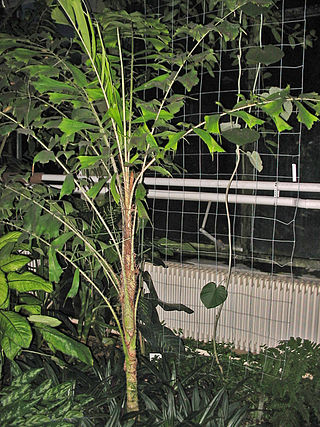
Aiphanes is a genus of spiny palms which is native to tropical regions of South and Central America and the Caribbean. There are about 26 species in the genus, ranging in size from understorey shrubs with subterranean stems to subcanopy trees as tall as 20 metres (66 ft). Most have pinnately compound leaves ; one species has entire leaves. Stems, leaves and sometimes even the fruit are covered with spines. Plants flower repeatedly over the course of their lifespan and have separate male and female flowers, although these are borne together on the same inflorescence. Although records of pollinators are limited, most species appear to be pollinated by insects. The fruit are eaten by several birds and mammals, including at least two species of amazon parrots.
Bactris jamaicana is a spiny palm which grows in multi-stemmed clumps. It is endemic to Jamaica.
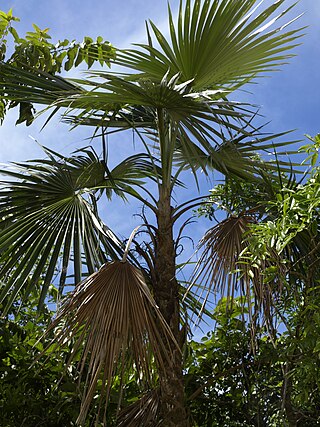
Coccothrinax argentea is a palm which is endemic to Hispaniola.

Calyptronoma is a genus in the palm family, native to the Greater Antilles. They have pinnately compound leaves with short petioles. The name was coined by August Grisebach who first described the genus in his 1846 Flora of the British West Indian Islands.
Calyptronoma occidentalis is a pinnately compound leaved palm species which is endemic to Jamaica. C. occidentalis stems grow singly and reach heights of 7–12 m, with stems 17–20 cm in diameter. It grows in waterlogged areas near the banks of streams, up to an elevation of 800 m above sea level.

Calyptronoma rivalis is a pinnately compound leaved palm species that is native to the Caribbean islands of Hispaniola and Puerto Rico. Its common names include palma de manaca and Puerto Rican manac.

Zombia antillarum, commonly known as the zombie palm, is a species of palm tree and the only member of the genus Zombia. It is endemic to the island of Hispaniola in the Greater Antilles. Usually found in dry, hilly areas of northern and southern Haiti and the northwest of the Dominican Republic, Z. antillarum is a relatively short fan palm with clustered stems and a very distinctive appearance caused by its persistent spiny leaf sheaths. Threatened by habitat destruction in Haiti, Z. antillarum is a popular ornamental species due to its distinctive appearance, low maintenance requirements and salt tolerance.
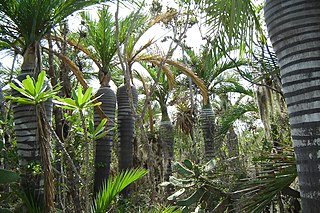
Pseudophoenix ekmanii is a palm species endemic to the Barahona Peninsula and Isla Beata in the Dominican Republic on the Caribbean island of Hispaniola.
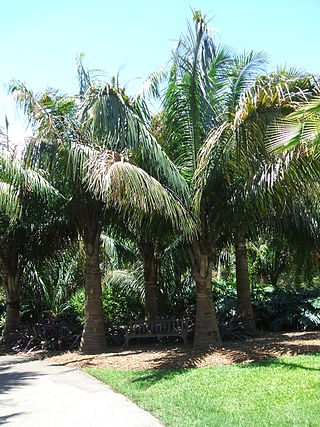
Attalea crassispatha is a palm which is endemic to southwest Haiti. The most geographically isolated member of the genus, it is considered a critically endangered species and has been called one of the rarest palms in the Americas.

Schippia concolor, the mountain pimento or silver pimento, is a medium-sized palm species that is native to Belize and Guatemala. Named for its discoverer, Australian botanist William A. Schipp, the species is threatened by habitat loss. It is the sole species in the genus Schippia.
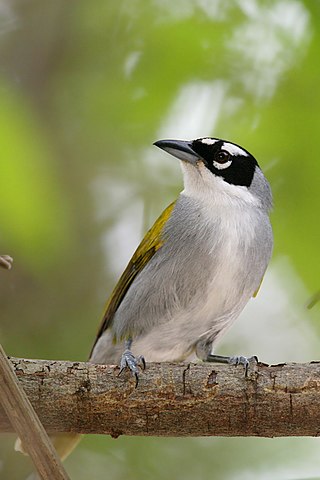
The black-crowned palm-tanager or black-crowned tanager is a species of bird of the family Phaenicophilidae, the Hispaniolan palm-tanagers. It is endemic to the island of Hispaniola which is shared by Haiti and the Dominican Republic.

Coccothrinax ekmanii, also known in Haitian Creole as gwenn or in Dominican Spanish as palma de guano, is an endangered species of palm which is endemic to the island of Hispaniola.
Coccothrinax jamaicensis, the silver thatch or Jamaican silver thatch, is a fan palm that is endemic to Jamaica.

Sabal domingensis, the Hispaniola palmetto, is a species of palm which is native to Hispaniola and Cuba.

Roystonea borinquena, commonly called the Puerto Rico royal palm, is a species of palm which is native to Hispaniola, Puerto Rico and the Virgin Islands.

Leucothrinax morrisii, the Key thatch palm, is a small palm which is native to the Greater Antilles, northern Lesser Antilles, The Bahamas and Florida and the Florida Keys in the United States.

The Cuban moist forests is a tropical moist broadleaf forest ecoregion that occupies 21,400 km2 on Cuba and Isla de la Juventud. The ecoregion receives more than 2,000 mm (79 in) of rainfall annually, and does not have a dry season. Soils are usually derived from quartz, limestone, or serpentinites. Cuban moist forests can be differentiated into lowland forests, sub-montane forests, and montane forests.

Sabal causiarum, commonly known as the Puerto Rico palmetto or Puerto Rican hat palm, is a species of palm which is native to Hispaniola, Puerto Rico, and the British Virgin Islands. As its common and scientific names suggest, its leaves are used in the manufacture of "straw" hats.
Coccothrinax jimenezii is a fan palm which is endemic to the island of Hispaniola in the Caribbean. First formally described in 2013, the species is only known from two small populations, and is considered critically endangered.















